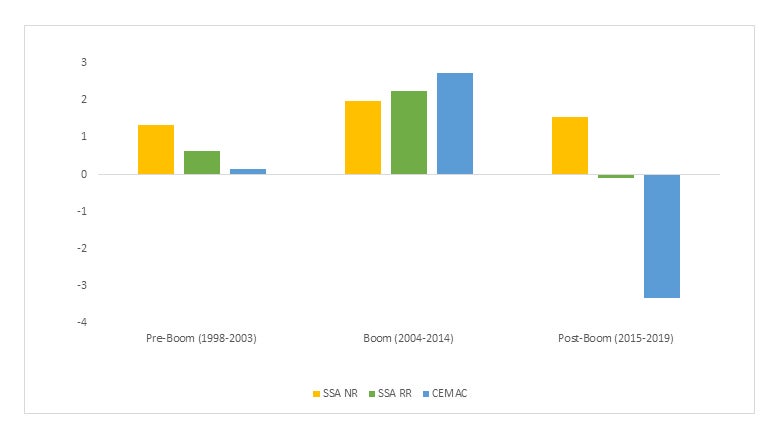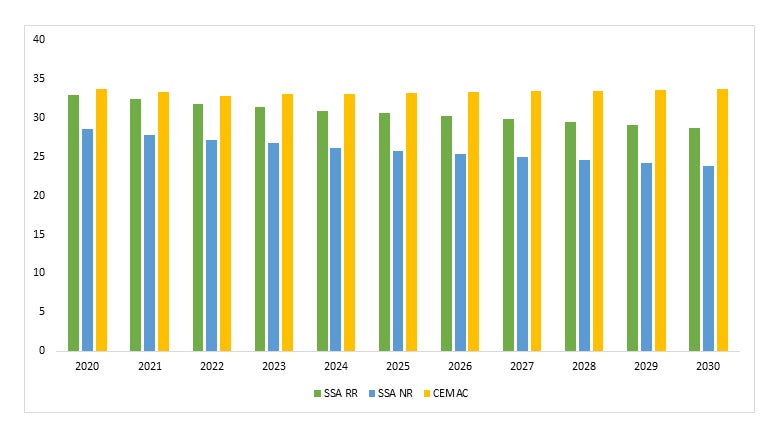 Seizing the moment: How can CEMAC countries navigate future commodity booms to promote sustained development?
Seizing the moment: How can CEMAC countries navigate future commodity booms to promote sustained development?
Sub-Saharan African (SSA) countries, including those in the CEMAC (Economic and Monetary Community of Central Africa) region are endowed with abundant natural resources that hold significant potential for economic growth. But in many instances, these opportunities were wasted, and results were disappointing: resource-rich countries in SSA often have registered lower economic growth and higher inequality than those without such resources – a phenomenon referred to as the “resource curse”. A recent World Bank report, which expands on the research conducted by Cust et al. (2022)i , undertakes a comparative study between the CEMAC region and other SSA countries and provides the following key findings.
1. Economic growth in resource-rich countries increased during the last commodity price boom (over the period 2004-2014) and was driven by resource export earnings. But their economic performance collapsed afterwards, as the volatility of commodity prices undermined development gains achieved during booms (Figures 1 and 2). The decline in per capita GDP growth was particularly pronounced within CEMAC countries.
Figure 1. Average of total fiscal revenues and resource revenues for resource rich SSA countries (in percent of GDP).

Source: UNU-WIDER Government Revenue Dataset 2022.
Note: NR= SSA Non-Resource countries; RR: SSA Resource-Rich countries. Resource-rich countries are those that had at least 20% of resource revenues/ exports in total government revenues/merchandise exports between 1998-2003 (as per Cust et al., 2022).
Figure 2. Average annual growth in GDP per capita by country group (percentage change).

Source: World Development Indicators, World Bank.
Note: NR= SSA Non-Resource countries; RR: SSA Resource-Rich countries; Equatorial Guinea is excluded from the Pre-Boom average due to outlier issues (growth rates up to 140%).
2. CEMAC countries, like many other in SSA, failed to transform natural resource revenues into productive forms of capital, including human and physical capital, which are key components of economic growth. The growth of total wealth per capita was lower in the CEMAC region, both when compared to other resource-rich and non-resource rich SSA countries (Figure 3).
Figure 3. Average annual growth in total wealth per capita (percentage change).

Source: Changing Wealth of Nations, World Bank.
Note: NR= SSA Non-Resource countries; RR: SSA Resource-Rich countries.
3. CEMAC’s adjusted net savings (in percent of GNI) were, on average, negative, indicating that the countries of the region were exhausting their natural resources without effectively converting them into other forms of capital (Figure 4).
Figure 4. Adjusted Net Savings (% of GNI).

Source: Changing Wealth of Nations, World Bank.
Note: RR: SSA Resource-Rich countries. ANS data for Equatorial Guinea is not available.
4. By the end of the last boom, inequality had not declined in many resource-rich countries, whereas it had declined in most non-resource-rich countries.ii Moreover, the poverty rate (at $ 2.15) remained persistently higher in CEMAC countries compared to both resource-rich SSA and their non-resource-rich counterparts. Recent World Bank projections estimate a gradual reduction in the poverty rate until 2030 in SSA, however, the gap in the poverty headcount ratio between resource-rich and non-resource-rich SSA countries is expected to remain significant at around 5 percentage points (Figure 5).
Figure 5. Poverty Headcount Projections (in percent), 2020-2030.

Source: World Bank Wealth of Nations; World Bank. "To end extreme poverty, getting back to pre-COVID-19 reduction rates is not enough." November 30, 2022. https://blogs.worldbank.org/developmenttalk/end-extreme-poverty-getting-back-pre-covid-19-reduction-rates-not-enough.
Note: NR= SSA Non-Resource countries; RR: SSA Resource-Rich countries.
- Resource-rich CEMAC countries should focus on converting natural resources into other forms of wealth, that is, using natural resources to invest in physical capital, human capital, and institutions (or intangible capital), with the goal of achieving a better balance between natural resources and the other assets.iii
- Effective institutions are key in helping resource-dependent countries escape the resource curse. For example, Botswana and Chileiv are success stories among developing countries thanks to sound economic policies and prudent economic management, including in managing resource wealth and breaking the cycle of pro-cyclical fiscal policies.
Ongoing reforms as part of the second CEMAC’s Economic and Financial Reforms Program (PREF-CEMAC II) are a welcome step. CEMAC institutions and member-states have made progress in the reform agenda, including in implementing financial inclusion strategies and promoting economic diversification but more needs to be done. The timely and effective implementation of the policies foreseen in PREF-CEMAC II remains key for fostering a stronger, sustained, pro-poor and inclusive, and more diversified growth path in Central Africa.
i Cust, J., Rivera, B. A., and Zeufack, A. 2022. The Dog that Didn’t Bark: The Missed Opportunity of Africa’s Resource Boom. Policy Research Working Paper; 10120.
ii Cust et al. (2022).
iii Van Eeghen, M. W., Gill, I., Izvorski, I., and De Rosa, D. 2013. Diversified development : making the most of natural resources in Eurasia (English). Europe and Central Asia Studies Washington, D.C. : World Bank Group.
iv Izvorski, I., Coulibaly, S., and Doumbia, D. 2018. Reinvigorating Growth in Resource-Rich Sub-Saharan Africa; Reinvigorating Growth in Resource-Rich Sub-Saharan Africa. © World Bank, Washington, DC.



Join the Conversation